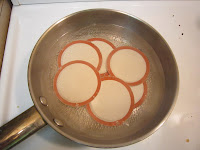Saurkraut.
If you don't like it - I can't help you. If you enjoy pungent, home made, lacto-fermented natural foods, you have come to the right place!
 Step 1) Thinly slice organic cabbage into shreds
Step 1) Thinly slice organic cabbage into shredsStep 2) Salt and smash cabbage. Bruise it up nicely. Mortar and pestle works, or just your fists in a big clean bowl.
Step 3) Press into a food grade container. The salt should draw enough liquid out to cover the cabbage. Obviously - I used a canning jar. Because canning jars are my answer to almost everything.


Step 4) Cover and weight down the future kraut. I used a plastic lid cut to size, and a smaller jar of water. If there isn't enough water for an inch of brine, add some boiled and cooled salt water to keep this covered. The salt water is like a protective layer to protect your krauty goodness.
 |
| The fresh, green, unfermented jar |
Step 6) Taste. When ready refrigerate to slow fermentation.
Step 7) Remember to use clean, non-reactive utensils to retrive the sauerkraut. This can be a plastic or wooden spoon, I like chopsticks because my jar is deep.
If you want to continue, salt and smash some fresh cabbage, empty your jar and add the new cabbage to the bottom.
 | |
| Finished: my sauerkraut hanging out in the fridge. Afterthought - perhaps I should have cleaned my fridge. |
Usual Disclaimer: if you do this wrong you may make yourself ill. Lacto-fermented foods done wrong mean either the yeast or bacteria takes over the other.. I just happen to be the owner of a steel stomach, and friendly bacterial environment in my house. Also I am crazy neurotic about using only clean, sanitized, non metallic tools for this.
It gets better tasting the long it sits, and looses more and more color.
Justify the purchase of totally unhealthy perogies and gobble. Also enjoyed on smash up of day old boiled potatoes, onion and a bit of bacon left over from breakfast.
Enjoy!



















